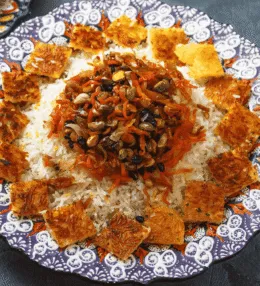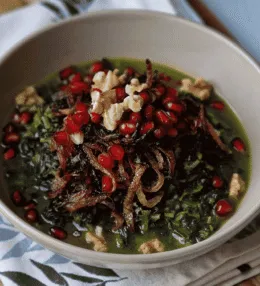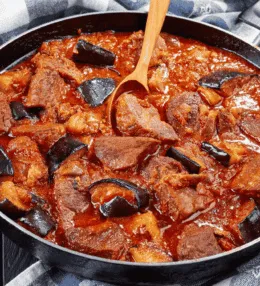
- View
Table of Contents
ToggleBaião de Dois is a dish that carries the heart of Brazil’s north eastern cuisine, bringing together two of the region’s most beloved staples: rice and beans. It’s a meal that exemplifies comfort, nourishment, and community, often enjoyed at family gatherings and celebrations.
Baião de Dois is more than just rice and beans, though. With the addition of flavourful meats and local ingredients, it becomes a dish that bursts with rich, layered flavours. For many, it represents the essence of home cooking in Brazil.
Want to dive deeper into Brazilian Cuisine? Don’t miss our post on 26 Traditional Brazilian Foods to Try
What Is Baião de Dois?
Baião de Dois is a traditional Brazilian dish that combines rice and beans with a savoury mix of meats, often pork or beef, and sometimes even dried or salted meat, known as carne de sol.
The dish gets its name from a local Brazilian music genre, “Baião,” and the “de Dois” refers to the two key ingredients, rice and beans, which dance together in perfect harmony.
It’s a dish that’s as rich in flavour as it is in history, with deep roots in the north eastern regions of Brazil, particularly in states like Ceará and Pernambuco.
The dish is cooked in a single pot, which allows the ingredients to meld together beautifully, creating a creamy, hearty texture that’s deeply satisfying. Each element, rice, beans, and meat plays an important role, but it’s the combination that makes Baião de Dois so special.
The dish often includes local cheese, fresh herbs like cilantro, and sometimes even a hint of cassava flour, further enhancing its depth of flavour.
Ingredients and Taste
The main ingredients in Baião de Dois are simple but full of potential when brought together. Black-eyed peas or other local beans are the foundation, cooked until they are soft but still retain a bit of bite. Rice is added to the pot, absorbing the savoury broth created by the beans and meat.
The meat, whether it’s pieces of pork, sausage, or carne de sol, infuses the dish with rich, smoky flavours. Garlic, onions, and peppers are commonly sautéed at the beginning to build the flavour base.
Local cheese, often queijo coalho, is added towards the end, offering a creamy, slightly salty contrast to the hearty beans and rice. Cilantro or parsley is sprinkled on top, adding a burst of freshness.
The result is a dish that is both comforting and complex, with smoky, savoury, and slightly creamy notes all coming together in a harmonious balance. Each bite is a reminder of the simplicity of its ingredients, elevated by the way they blend together into something deeply satisfying.
A Taste of History
Baião de Dois has a long history in north eastern Brazil, where it has been a staple for centuries. In a region that has often faced economic hardship and harsh climates, rice and beans became essential, as both were easy to store and cook.
The dish emerged as a way to maximize nourishment while using affordable, accessible ingredients. Over time, as local meats like carne de sol and sausage became more available, they were incorporated into the dish, transforming it from a humble meal into something more festive and flavourful.
The origins of Baião de Dois are intertwined with the cultural identity of the Brazilian northeast, a region known for its resilience and its vibrant culinary traditions. The name itself is a nod to the region’s musical roots, with Baião referring to a popular folk rhythm.
Just as the music brings people together, Baião de Dois has long been a communal dish, served at family gatherings, festivals, and celebrations.

Baião de Dois (Rice and Beans with Meat)
Ingredients
- 1 cup dried black-eyed peas or substitute with another type of dried beans
- 1 cup white rice
- 200 g 7 oz dried or smoked beef jerky (Carne de Sol) or bacon, diced
- 200 g 7 oz linguiça (smoked sausage), sliced
- 1 onion finely chopped
- 3 cloves garlic minced
- 2 tbsp olive oil
- 1/2 cup grated queijo coalho Brazilian cheese or feta cheese
- 1/4 cup fresh cilantro chopped
- 1/4 cup green onions chopped
- Salt and pepper to taste
- 4 cups water or enough to cook beans and rice
- Optional: 1 chopped tomato and 1 chopped bell pepper for added flavour
Instructions
- Begin by rinsing the dried black-eyed peas under cold water. Place them in a pot with 4 cups of water and a pinch of salt. Bring to a boil, then lower the heat and simmer for 25-30 minutes until tender but not fully cooked. Drain and set aside.
- Rinse the rice under cold water until the water runs clear. Set aside in a bowl. This step removes excess starch from the rice, ensuring it stays fluffy during cooking.
- In a large pan or skillet, heat 2 tablespoons of olive oil over medium heat. Add the diced carne de sol (or bacon) and the sliced linguiça. Fry until the meat is browned and slightly crispy, about 6-8 minutes. Remove the meat from the pan and set aside, leaving the rendered fat in the pan for extra flavour.
- In the same pan, add the chopped onion and minced garlic. Sauté for 3-4 minutes until the onions become soft and translucent, absorbing the flavours of the meat drippings.
- Add the rinsed rice to the pan, stirring to coat the grains in the oil and aromatics. Toast the rice for 2-3 minutes, which enhances its flavour and texture.
- Return the cooked black-eyed peas and the browned meats to the pan. Stir gently to combine, ensuring the ingredients are well distributed. Season with salt and pepper to taste. At this point, you can also add chopped tomatoes and bell peppers for extra flavour and texture if desired.
- Pour enough water (about 2 cups) to cover the mixture. Bring the mixture to a gentle boil, then lower the heat, cover, and simmer for 15-20 minutes, or until the rice is cooked and the liquid has absorbed. Stir occasionally to prevent sticking.
- Once the rice is tender and the flavours have melded together, stir in the grated queijo coalho or feta cheese, allowing it to melt slightly. Garnish with chopped cilantro and green onions for a fresh, herbaceous finish. Serve hot, accompanied by a simple green salad or sautéed vegetables.
Nutrition
You May Also Like






